Case Study on Contract Law 2022
VerifiedAdded on 2022/09/18
|9
|2295
|26
AI Summary
Contribute Materials
Your contribution can guide someone’s learning journey. Share your
documents today.
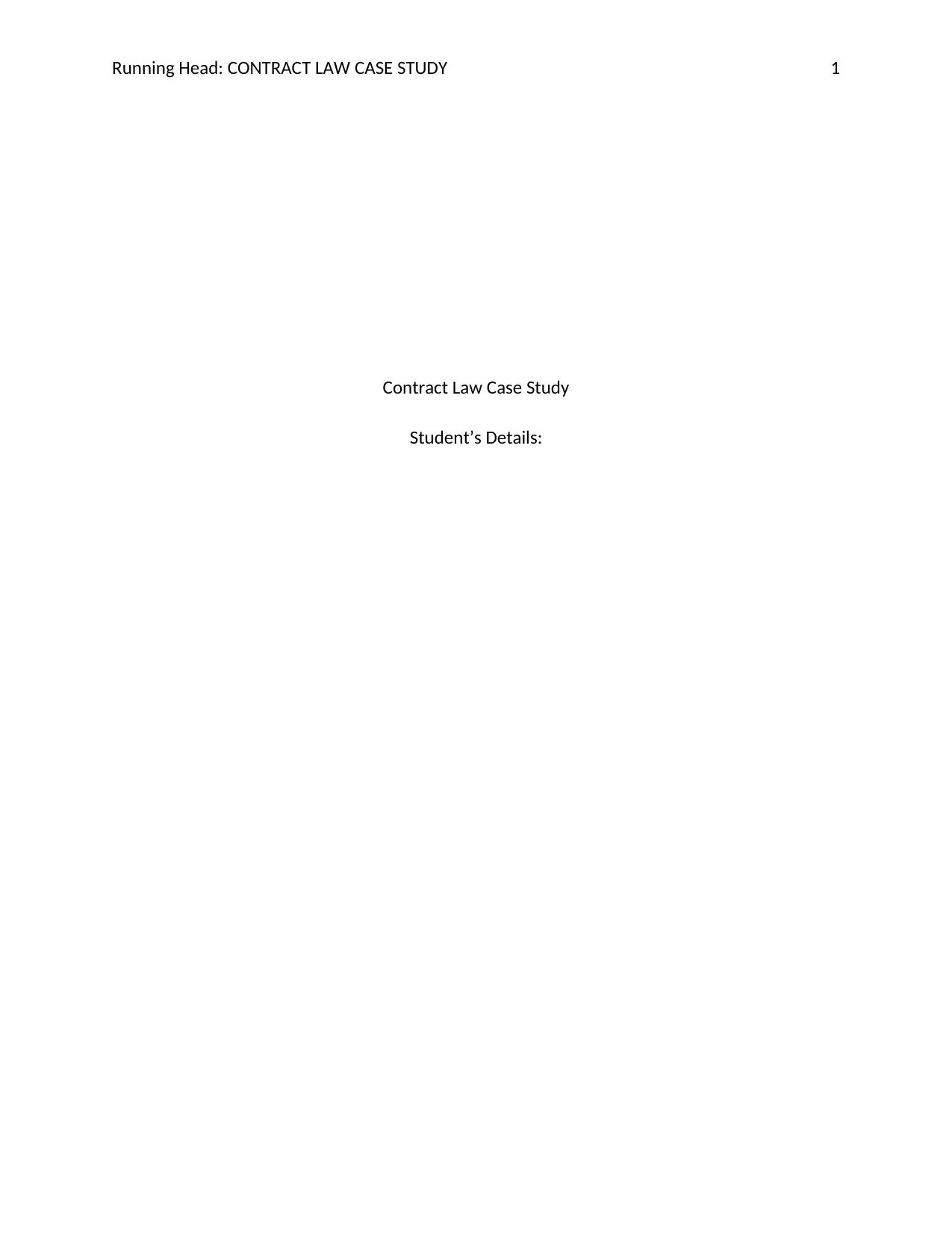
Running Head: CONTRACT LAW CASE STUDY 1
Contract Law Case Study
Student’s Details:
Contract Law Case Study
Student’s Details:
Secure Best Marks with AI Grader
Need help grading? Try our AI Grader for instant feedback on your assignments.
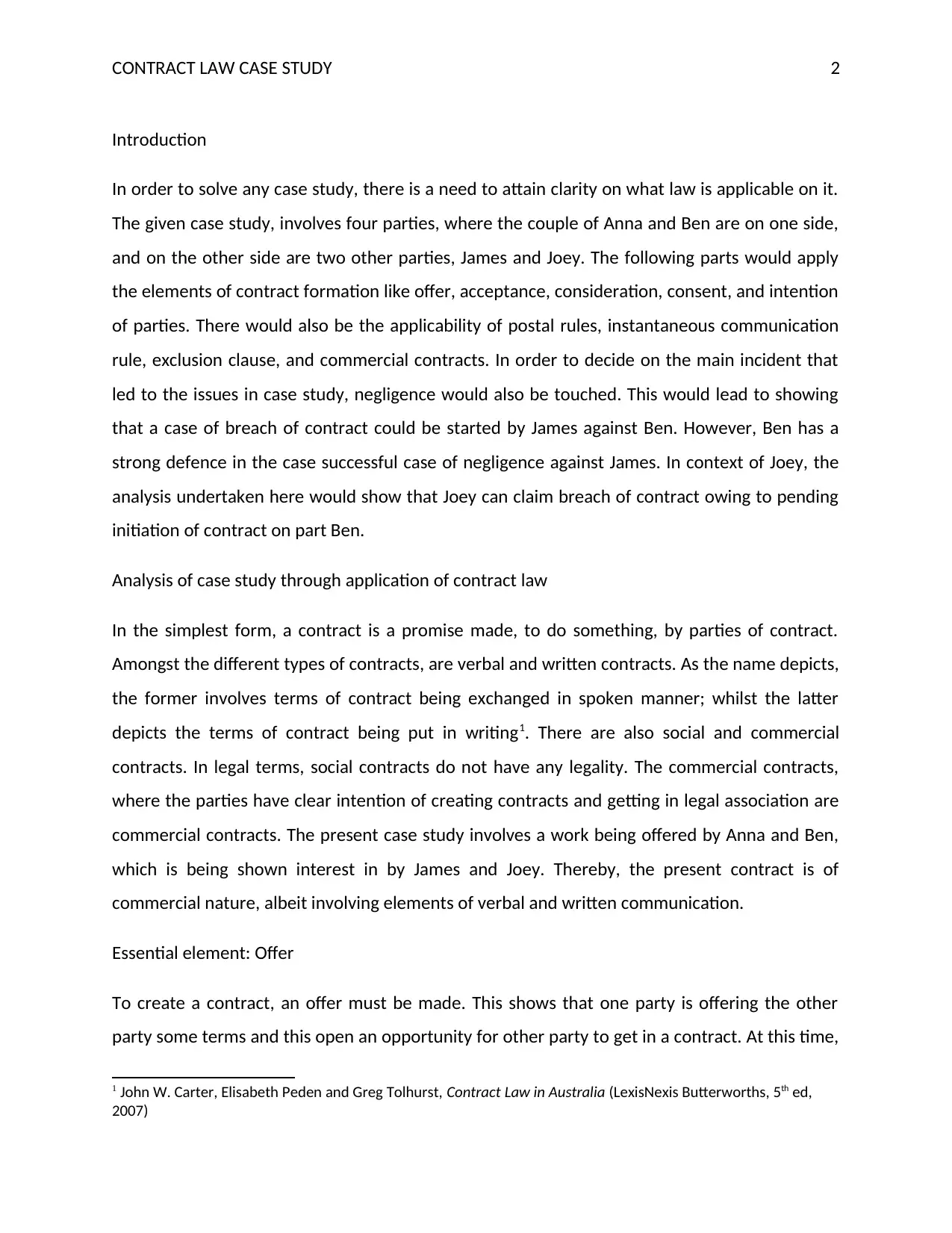
CONTRACT LAW CASE STUDY 2
Introduction
In order to solve any case study, there is a need to attain clarity on what law is applicable on it.
The given case study, involves four parties, where the couple of Anna and Ben are on one side,
and on the other side are two other parties, James and Joey. The following parts would apply
the elements of contract formation like offer, acceptance, consideration, consent, and intention
of parties. There would also be the applicability of postal rules, instantaneous communication
rule, exclusion clause, and commercial contracts. In order to decide on the main incident that
led to the issues in case study, negligence would also be touched. This would lead to showing
that a case of breach of contract could be started by James against Ben. However, Ben has a
strong defence in the case successful case of negligence against James. In context of Joey, the
analysis undertaken here would show that Joey can claim breach of contract owing to pending
initiation of contract on part Ben.
Analysis of case study through application of contract law
In the simplest form, a contract is a promise made, to do something, by parties of contract.
Amongst the different types of contracts, are verbal and written contracts. As the name depicts,
the former involves terms of contract being exchanged in spoken manner; whilst the latter
depicts the terms of contract being put in writing1. There are also social and commercial
contracts. In legal terms, social contracts do not have any legality. The commercial contracts,
where the parties have clear intention of creating contracts and getting in legal association are
commercial contracts. The present case study involves a work being offered by Anna and Ben,
which is being shown interest in by James and Joey. Thereby, the present contract is of
commercial nature, albeit involving elements of verbal and written communication.
Essential element: Offer
To create a contract, an offer must be made. This shows that one party is offering the other
party some terms and this open an opportunity for other party to get in a contract. At this time,
1 John W. Carter, Elisabeth Peden and Greg Tolhurst, Contract Law in Australia (LexisNexis Butterworths, 5th ed,
2007)
Introduction
In order to solve any case study, there is a need to attain clarity on what law is applicable on it.
The given case study, involves four parties, where the couple of Anna and Ben are on one side,
and on the other side are two other parties, James and Joey. The following parts would apply
the elements of contract formation like offer, acceptance, consideration, consent, and intention
of parties. There would also be the applicability of postal rules, instantaneous communication
rule, exclusion clause, and commercial contracts. In order to decide on the main incident that
led to the issues in case study, negligence would also be touched. This would lead to showing
that a case of breach of contract could be started by James against Ben. However, Ben has a
strong defence in the case successful case of negligence against James. In context of Joey, the
analysis undertaken here would show that Joey can claim breach of contract owing to pending
initiation of contract on part Ben.
Analysis of case study through application of contract law
In the simplest form, a contract is a promise made, to do something, by parties of contract.
Amongst the different types of contracts, are verbal and written contracts. As the name depicts,
the former involves terms of contract being exchanged in spoken manner; whilst the latter
depicts the terms of contract being put in writing1. There are also social and commercial
contracts. In legal terms, social contracts do not have any legality. The commercial contracts,
where the parties have clear intention of creating contracts and getting in legal association are
commercial contracts. The present case study involves a work being offered by Anna and Ben,
which is being shown interest in by James and Joey. Thereby, the present contract is of
commercial nature, albeit involving elements of verbal and written communication.
Essential element: Offer
To create a contract, an offer must be made. This shows that one party is offering the other
party some terms and this open an opportunity for other party to get in a contract. At this time,
1 John W. Carter, Elisabeth Peden and Greg Tolhurst, Contract Law in Australia (LexisNexis Butterworths, 5th ed,
2007)
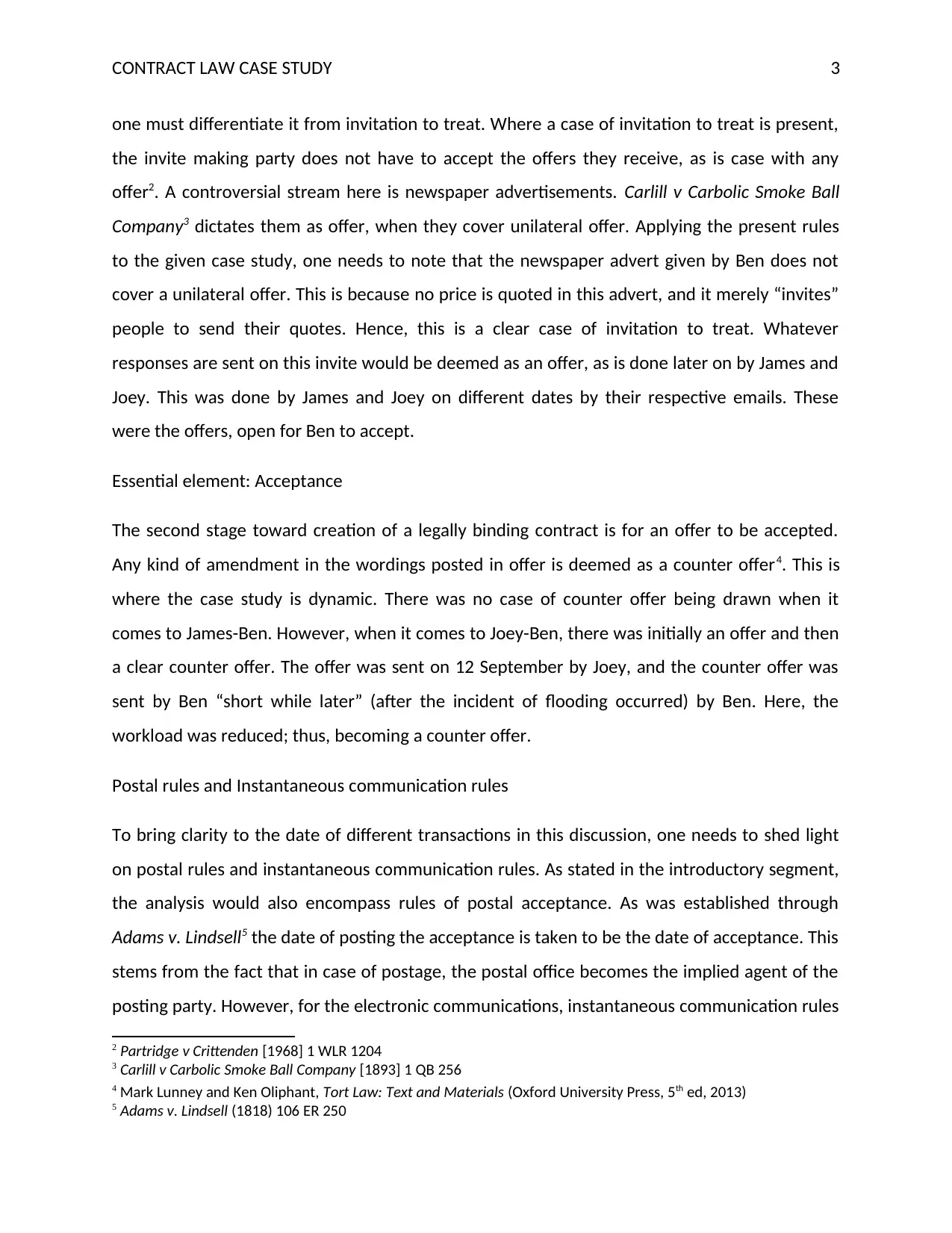
CONTRACT LAW CASE STUDY 3
one must differentiate it from invitation to treat. Where a case of invitation to treat is present,
the invite making party does not have to accept the offers they receive, as is case with any
offer2. A controversial stream here is newspaper advertisements. Carlill v Carbolic Smoke Ball
Company3 dictates them as offer, when they cover unilateral offer. Applying the present rules
to the given case study, one needs to note that the newspaper advert given by Ben does not
cover a unilateral offer. This is because no price is quoted in this advert, and it merely “invites”
people to send their quotes. Hence, this is a clear case of invitation to treat. Whatever
responses are sent on this invite would be deemed as an offer, as is done later on by James and
Joey. This was done by James and Joey on different dates by their respective emails. These
were the offers, open for Ben to accept.
Essential element: Acceptance
The second stage toward creation of a legally binding contract is for an offer to be accepted.
Any kind of amendment in the wordings posted in offer is deemed as a counter offer4. This is
where the case study is dynamic. There was no case of counter offer being drawn when it
comes to James-Ben. However, when it comes to Joey-Ben, there was initially an offer and then
a clear counter offer. The offer was sent on 12 September by Joey, and the counter offer was
sent by Ben “short while later” (after the incident of flooding occurred) by Ben. Here, the
workload was reduced; thus, becoming a counter offer.
Postal rules and Instantaneous communication rules
To bring clarity to the date of different transactions in this discussion, one needs to shed light
on postal rules and instantaneous communication rules. As stated in the introductory segment,
the analysis would also encompass rules of postal acceptance. As was established through
Adams v. Lindsell5 the date of posting the acceptance is taken to be the date of acceptance. This
stems from the fact that in case of postage, the postal office becomes the implied agent of the
posting party. However, for the electronic communications, instantaneous communication rules
2 Partridge v Crittenden [1968] 1 WLR 1204
3 Carlill v Carbolic Smoke Ball Company [1893] 1 QB 256
4 Mark Lunney and Ken Oliphant, Tort Law: Text and Materials (Oxford University Press, 5th ed, 2013)
5 Adams v. Lindsell (1818) 106 ER 250
one must differentiate it from invitation to treat. Where a case of invitation to treat is present,
the invite making party does not have to accept the offers they receive, as is case with any
offer2. A controversial stream here is newspaper advertisements. Carlill v Carbolic Smoke Ball
Company3 dictates them as offer, when they cover unilateral offer. Applying the present rules
to the given case study, one needs to note that the newspaper advert given by Ben does not
cover a unilateral offer. This is because no price is quoted in this advert, and it merely “invites”
people to send their quotes. Hence, this is a clear case of invitation to treat. Whatever
responses are sent on this invite would be deemed as an offer, as is done later on by James and
Joey. This was done by James and Joey on different dates by their respective emails. These
were the offers, open for Ben to accept.
Essential element: Acceptance
The second stage toward creation of a legally binding contract is for an offer to be accepted.
Any kind of amendment in the wordings posted in offer is deemed as a counter offer4. This is
where the case study is dynamic. There was no case of counter offer being drawn when it
comes to James-Ben. However, when it comes to Joey-Ben, there was initially an offer and then
a clear counter offer. The offer was sent on 12 September by Joey, and the counter offer was
sent by Ben “short while later” (after the incident of flooding occurred) by Ben. Here, the
workload was reduced; thus, becoming a counter offer.
Postal rules and Instantaneous communication rules
To bring clarity to the date of different transactions in this discussion, one needs to shed light
on postal rules and instantaneous communication rules. As stated in the introductory segment,
the analysis would also encompass rules of postal acceptance. As was established through
Adams v. Lindsell5 the date of posting the acceptance is taken to be the date of acceptance. This
stems from the fact that in case of postage, the postal office becomes the implied agent of the
posting party. However, for the electronic communications, instantaneous communication rules
2 Partridge v Crittenden [1968] 1 WLR 1204
3 Carlill v Carbolic Smoke Ball Company [1893] 1 QB 256
4 Mark Lunney and Ken Oliphant, Tort Law: Text and Materials (Oxford University Press, 5th ed, 2013)
5 Adams v. Lindsell (1818) 106 ER 250
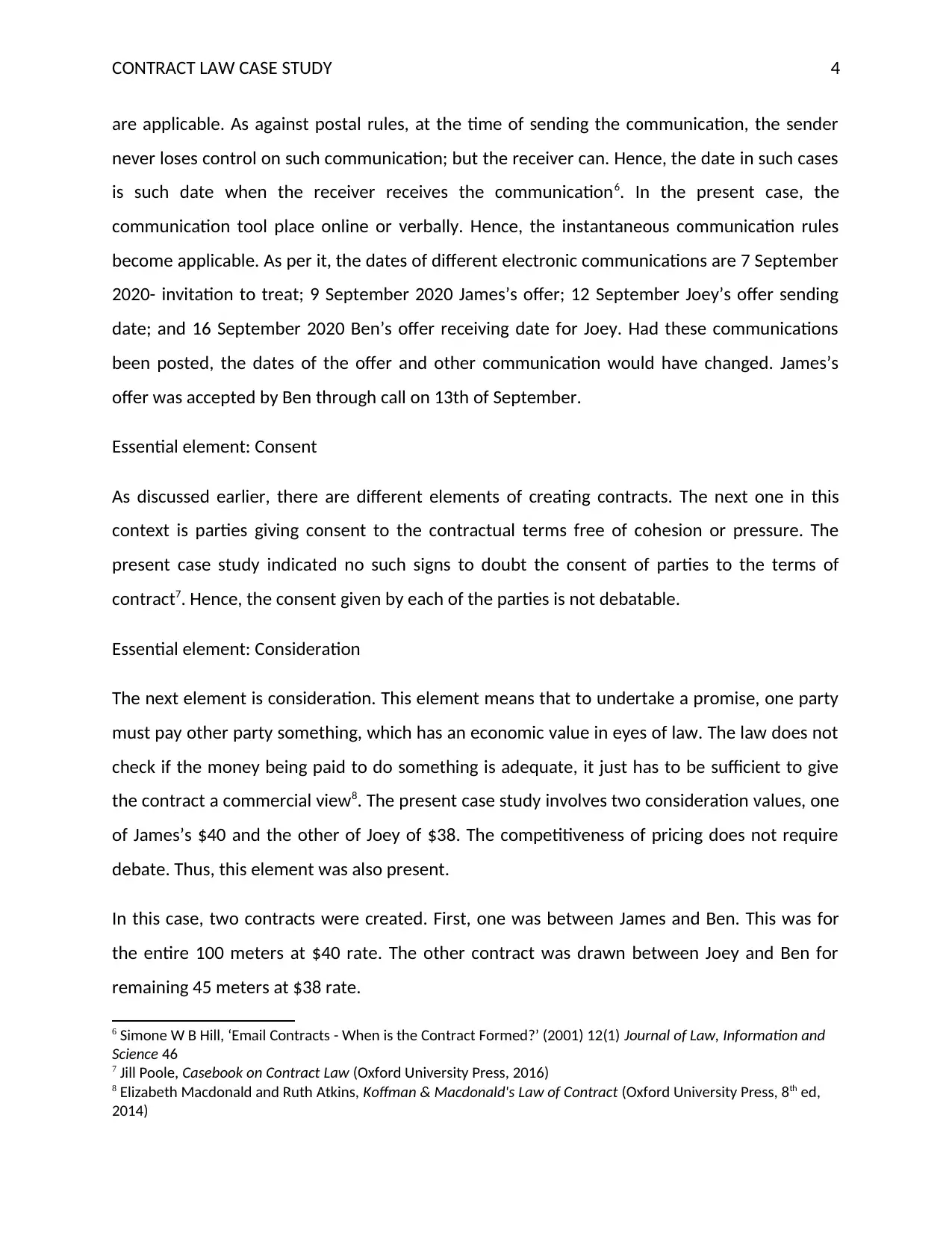
CONTRACT LAW CASE STUDY 4
are applicable. As against postal rules, at the time of sending the communication, the sender
never loses control on such communication; but the receiver can. Hence, the date in such cases
is such date when the receiver receives the communication6. In the present case, the
communication tool place online or verbally. Hence, the instantaneous communication rules
become applicable. As per it, the dates of different electronic communications are 7 September
2020- invitation to treat; 9 September 2020 James’s offer; 12 September Joey’s offer sending
date; and 16 September 2020 Ben’s offer receiving date for Joey. Had these communications
been posted, the dates of the offer and other communication would have changed. James’s
offer was accepted by Ben through call on 13th of September.
Essential element: Consent
As discussed earlier, there are different elements of creating contracts. The next one in this
context is parties giving consent to the contractual terms free of cohesion or pressure. The
present case study indicated no such signs to doubt the consent of parties to the terms of
contract7. Hence, the consent given by each of the parties is not debatable.
Essential element: Consideration
The next element is consideration. This element means that to undertake a promise, one party
must pay other party something, which has an economic value in eyes of law. The law does not
check if the money being paid to do something is adequate, it just has to be sufficient to give
the contract a commercial view8. The present case study involves two consideration values, one
of James’s $40 and the other of Joey of $38. The competitiveness of pricing does not require
debate. Thus, this element was also present.
In this case, two contracts were created. First, one was between James and Ben. This was for
the entire 100 meters at $40 rate. The other contract was drawn between Joey and Ben for
remaining 45 meters at $38 rate.
6 Simone W B Hill, ‘Email Contracts - When is the Contract Formed?’ (2001) 12(1) Journal of Law, Information and
Science 46
7 Jill Poole, Casebook on Contract Law (Oxford University Press, 2016)
8 Elizabeth Macdonald and Ruth Atkins, Koffman & Macdonald's Law of Contract (Oxford University Press, 8th ed,
2014)
are applicable. As against postal rules, at the time of sending the communication, the sender
never loses control on such communication; but the receiver can. Hence, the date in such cases
is such date when the receiver receives the communication6. In the present case, the
communication tool place online or verbally. Hence, the instantaneous communication rules
become applicable. As per it, the dates of different electronic communications are 7 September
2020- invitation to treat; 9 September 2020 James’s offer; 12 September Joey’s offer sending
date; and 16 September 2020 Ben’s offer receiving date for Joey. Had these communications
been posted, the dates of the offer and other communication would have changed. James’s
offer was accepted by Ben through call on 13th of September.
Essential element: Consent
As discussed earlier, there are different elements of creating contracts. The next one in this
context is parties giving consent to the contractual terms free of cohesion or pressure. The
present case study indicated no such signs to doubt the consent of parties to the terms of
contract7. Hence, the consent given by each of the parties is not debatable.
Essential element: Consideration
The next element is consideration. This element means that to undertake a promise, one party
must pay other party something, which has an economic value in eyes of law. The law does not
check if the money being paid to do something is adequate, it just has to be sufficient to give
the contract a commercial view8. The present case study involves two consideration values, one
of James’s $40 and the other of Joey of $38. The competitiveness of pricing does not require
debate. Thus, this element was also present.
In this case, two contracts were created. First, one was between James and Ben. This was for
the entire 100 meters at $40 rate. The other contract was drawn between Joey and Ben for
remaining 45 meters at $38 rate.
6 Simone W B Hill, ‘Email Contracts - When is the Contract Formed?’ (2001) 12(1) Journal of Law, Information and
Science 46
7 Jill Poole, Casebook on Contract Law (Oxford University Press, 2016)
8 Elizabeth Macdonald and Ruth Atkins, Koffman & Macdonald's Law of Contract (Oxford University Press, 8th ed,
2014)
Secure Best Marks with AI Grader
Need help grading? Try our AI Grader for instant feedback on your assignments.
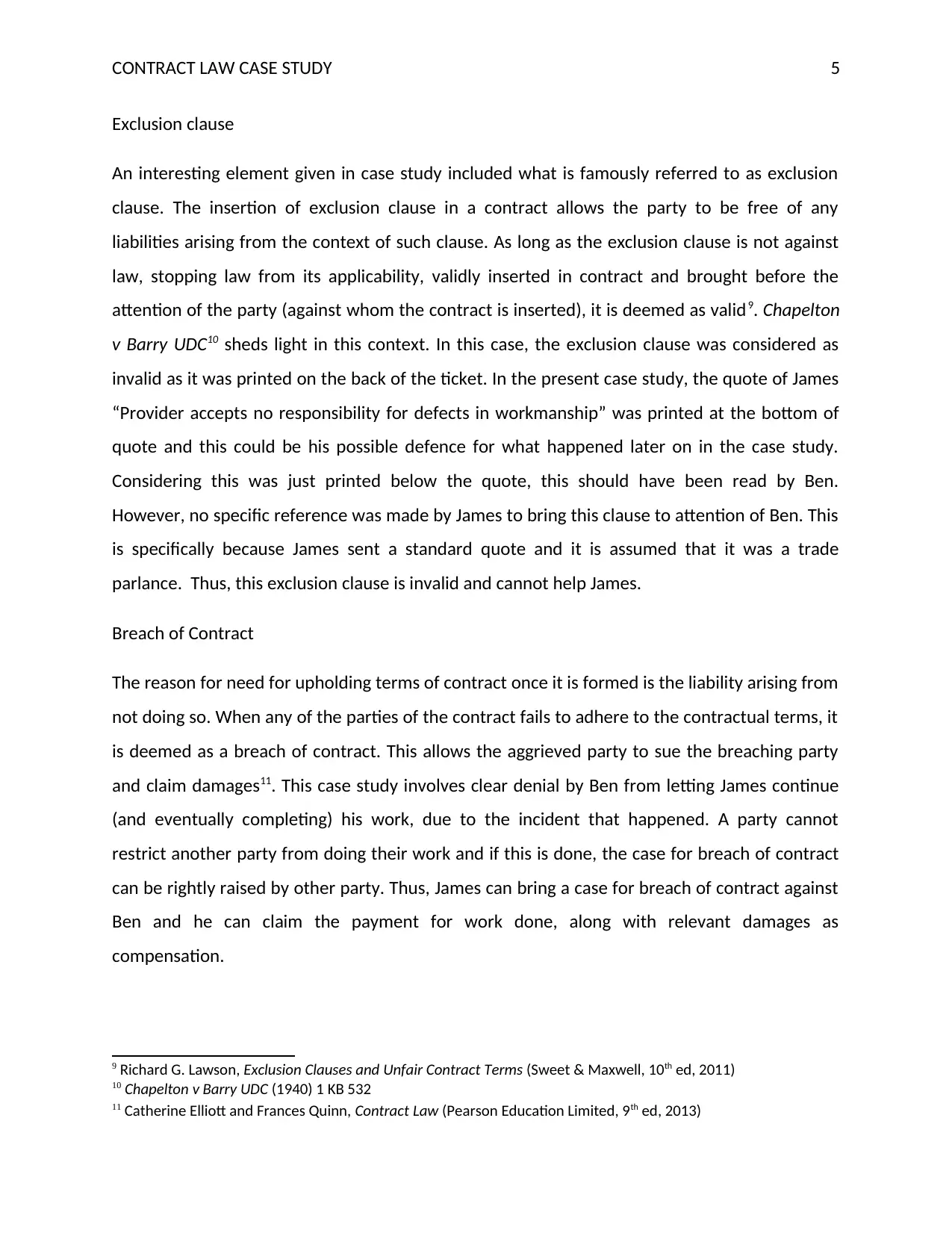
CONTRACT LAW CASE STUDY 5
Exclusion clause
An interesting element given in case study included what is famously referred to as exclusion
clause. The insertion of exclusion clause in a contract allows the party to be free of any
liabilities arising from the context of such clause. As long as the exclusion clause is not against
law, stopping law from its applicability, validly inserted in contract and brought before the
attention of the party (against whom the contract is inserted), it is deemed as valid9. Chapelton
v Barry UDC10 sheds light in this context. In this case, the exclusion clause was considered as
invalid as it was printed on the back of the ticket. In the present case study, the quote of James
“Provider accepts no responsibility for defects in workmanship” was printed at the bottom of
quote and this could be his possible defence for what happened later on in the case study.
Considering this was just printed below the quote, this should have been read by Ben.
However, no specific reference was made by James to bring this clause to attention of Ben. This
is specifically because James sent a standard quote and it is assumed that it was a trade
parlance. Thus, this exclusion clause is invalid and cannot help James.
Breach of Contract
The reason for need for upholding terms of contract once it is formed is the liability arising from
not doing so. When any of the parties of the contract fails to adhere to the contractual terms, it
is deemed as a breach of contract. This allows the aggrieved party to sue the breaching party
and claim damages11. This case study involves clear denial by Ben from letting James continue
(and eventually completing) his work, due to the incident that happened. A party cannot
restrict another party from doing their work and if this is done, the case for breach of contract
can be rightly raised by other party. Thus, James can bring a case for breach of contract against
Ben and he can claim the payment for work done, along with relevant damages as
compensation.
9 Richard G. Lawson, Exclusion Clauses and Unfair Contract Terms (Sweet & Maxwell, 10th ed, 2011)
10 Chapelton v Barry UDC (1940) 1 KB 532
11 Catherine Elliott and Frances Quinn, Contract Law (Pearson Education Limited, 9th ed, 2013)
Exclusion clause
An interesting element given in case study included what is famously referred to as exclusion
clause. The insertion of exclusion clause in a contract allows the party to be free of any
liabilities arising from the context of such clause. As long as the exclusion clause is not against
law, stopping law from its applicability, validly inserted in contract and brought before the
attention of the party (against whom the contract is inserted), it is deemed as valid9. Chapelton
v Barry UDC10 sheds light in this context. In this case, the exclusion clause was considered as
invalid as it was printed on the back of the ticket. In the present case study, the quote of James
“Provider accepts no responsibility for defects in workmanship” was printed at the bottom of
quote and this could be his possible defence for what happened later on in the case study.
Considering this was just printed below the quote, this should have been read by Ben.
However, no specific reference was made by James to bring this clause to attention of Ben. This
is specifically because James sent a standard quote and it is assumed that it was a trade
parlance. Thus, this exclusion clause is invalid and cannot help James.
Breach of Contract
The reason for need for upholding terms of contract once it is formed is the liability arising from
not doing so. When any of the parties of the contract fails to adhere to the contractual terms, it
is deemed as a breach of contract. This allows the aggrieved party to sue the breaching party
and claim damages11. This case study involves clear denial by Ben from letting James continue
(and eventually completing) his work, due to the incident that happened. A party cannot
restrict another party from doing their work and if this is done, the case for breach of contract
can be rightly raised by other party. Thus, James can bring a case for breach of contract against
Ben and he can claim the payment for work done, along with relevant damages as
compensation.
9 Richard G. Lawson, Exclusion Clauses and Unfair Contract Terms (Sweet & Maxwell, 10th ed, 2011)
10 Chapelton v Barry UDC (1940) 1 KB 532
11 Catherine Elliott and Frances Quinn, Contract Law (Pearson Education Limited, 9th ed, 2013)
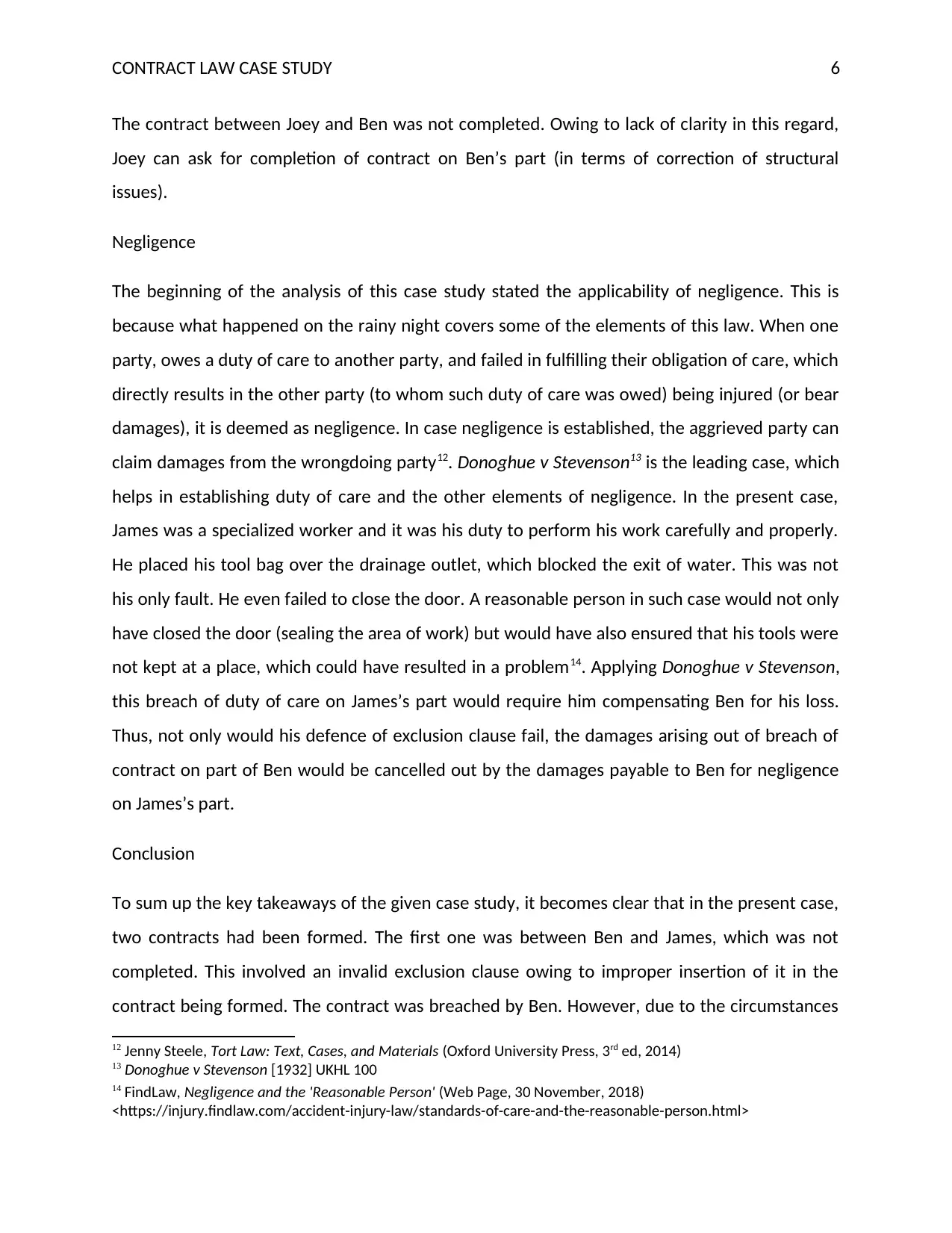
CONTRACT LAW CASE STUDY 6
The contract between Joey and Ben was not completed. Owing to lack of clarity in this regard,
Joey can ask for completion of contract on Ben’s part (in terms of correction of structural
issues).
Negligence
The beginning of the analysis of this case study stated the applicability of negligence. This is
because what happened on the rainy night covers some of the elements of this law. When one
party, owes a duty of care to another party, and failed in fulfilling their obligation of care, which
directly results in the other party (to whom such duty of care was owed) being injured (or bear
damages), it is deemed as negligence. In case negligence is established, the aggrieved party can
claim damages from the wrongdoing party12. Donoghue v Stevenson13 is the leading case, which
helps in establishing duty of care and the other elements of negligence. In the present case,
James was a specialized worker and it was his duty to perform his work carefully and properly.
He placed his tool bag over the drainage outlet, which blocked the exit of water. This was not
his only fault. He even failed to close the door. A reasonable person in such case would not only
have closed the door (sealing the area of work) but would have also ensured that his tools were
not kept at a place, which could have resulted in a problem14. Applying Donoghue v Stevenson,
this breach of duty of care on James’s part would require him compensating Ben for his loss.
Thus, not only would his defence of exclusion clause fail, the damages arising out of breach of
contract on part of Ben would be cancelled out by the damages payable to Ben for negligence
on James’s part.
Conclusion
To sum up the key takeaways of the given case study, it becomes clear that in the present case,
two contracts had been formed. The first one was between Ben and James, which was not
completed. This involved an invalid exclusion clause owing to improper insertion of it in the
contract being formed. The contract was breached by Ben. However, due to the circumstances
12 Jenny Steele, Tort Law: Text, Cases, and Materials (Oxford University Press, 3rd ed, 2014)
13 Donoghue v Stevenson [1932] UKHL 100
14 FindLaw, Negligence and the 'Reasonable Person' (Web Page, 30 November, 2018)
<https://injury.findlaw.com/accident-injury-law/standards-of-care-and-the-reasonable-person.html>
The contract between Joey and Ben was not completed. Owing to lack of clarity in this regard,
Joey can ask for completion of contract on Ben’s part (in terms of correction of structural
issues).
Negligence
The beginning of the analysis of this case study stated the applicability of negligence. This is
because what happened on the rainy night covers some of the elements of this law. When one
party, owes a duty of care to another party, and failed in fulfilling their obligation of care, which
directly results in the other party (to whom such duty of care was owed) being injured (or bear
damages), it is deemed as negligence. In case negligence is established, the aggrieved party can
claim damages from the wrongdoing party12. Donoghue v Stevenson13 is the leading case, which
helps in establishing duty of care and the other elements of negligence. In the present case,
James was a specialized worker and it was his duty to perform his work carefully and properly.
He placed his tool bag over the drainage outlet, which blocked the exit of water. This was not
his only fault. He even failed to close the door. A reasonable person in such case would not only
have closed the door (sealing the area of work) but would have also ensured that his tools were
not kept at a place, which could have resulted in a problem14. Applying Donoghue v Stevenson,
this breach of duty of care on James’s part would require him compensating Ben for his loss.
Thus, not only would his defence of exclusion clause fail, the damages arising out of breach of
contract on part of Ben would be cancelled out by the damages payable to Ben for negligence
on James’s part.
Conclusion
To sum up the key takeaways of the given case study, it becomes clear that in the present case,
two contracts had been formed. The first one was between Ben and James, which was not
completed. This involved an invalid exclusion clause owing to improper insertion of it in the
contract being formed. The contract was breached by Ben. However, due to the circumstances
12 Jenny Steele, Tort Law: Text, Cases, and Materials (Oxford University Press, 3rd ed, 2014)
13 Donoghue v Stevenson [1932] UKHL 100
14 FindLaw, Negligence and the 'Reasonable Person' (Web Page, 30 November, 2018)
<https://injury.findlaw.com/accident-injury-law/standards-of-care-and-the-reasonable-person.html>
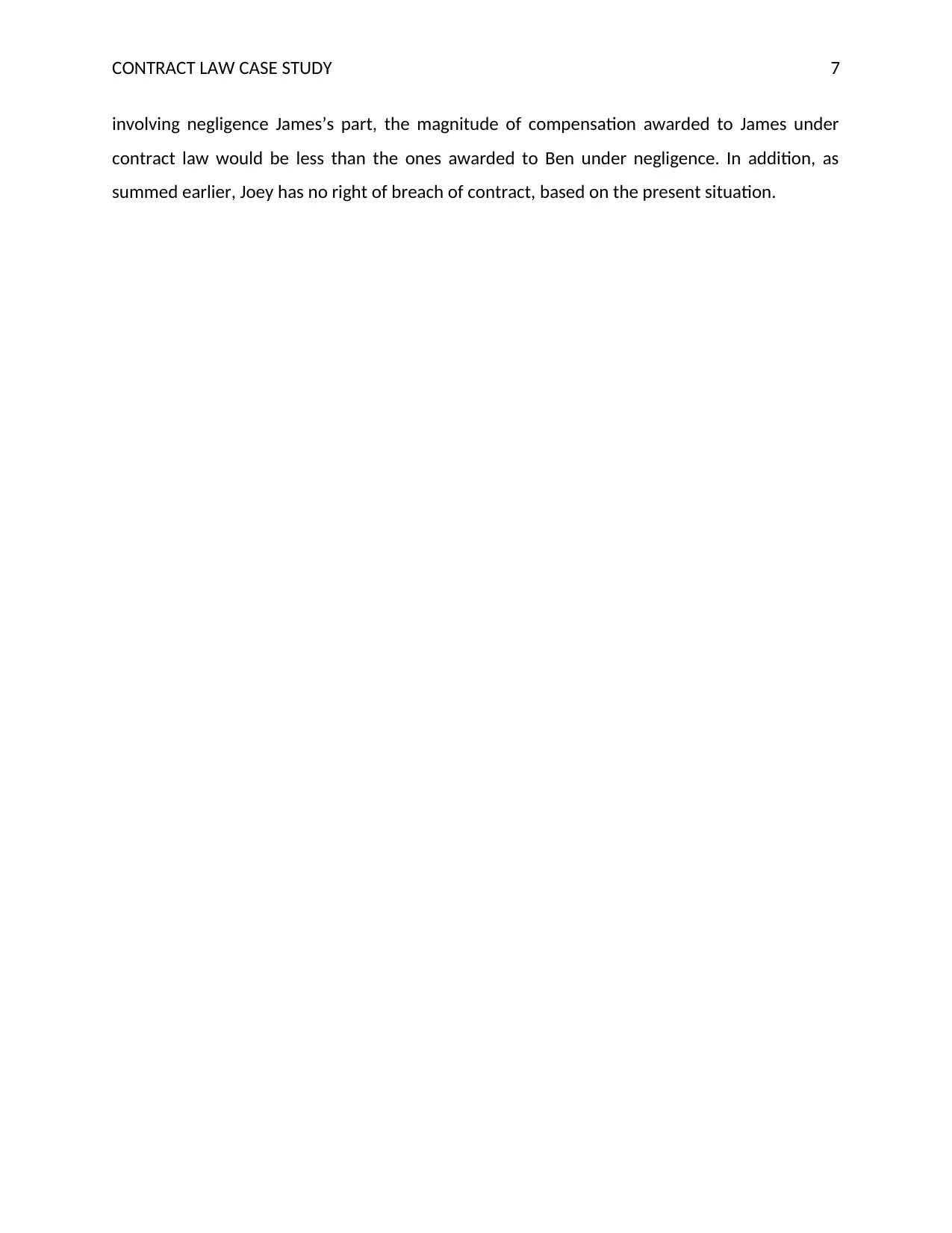
CONTRACT LAW CASE STUDY 7
involving negligence James’s part, the magnitude of compensation awarded to James under
contract law would be less than the ones awarded to Ben under negligence. In addition, as
summed earlier, Joey has no right of breach of contract, based on the present situation.
involving negligence James’s part, the magnitude of compensation awarded to James under
contract law would be less than the ones awarded to Ben under negligence. In addition, as
summed earlier, Joey has no right of breach of contract, based on the present situation.
Paraphrase This Document
Need a fresh take? Get an instant paraphrase of this document with our AI Paraphraser
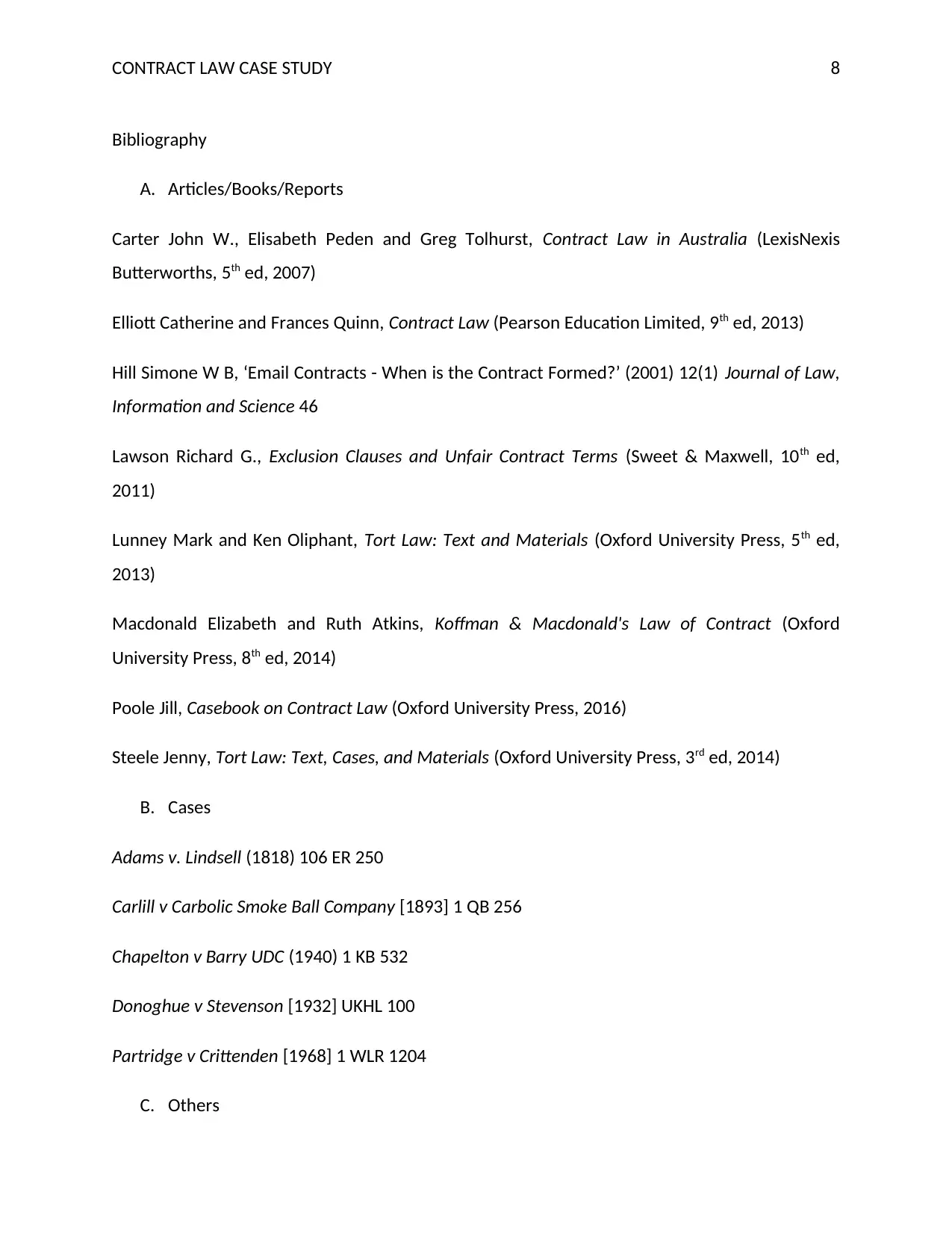
CONTRACT LAW CASE STUDY 8
Bibliography
A. Articles/Books/Reports
Carter John W., Elisabeth Peden and Greg Tolhurst, Contract Law in Australia (LexisNexis
Butterworths, 5th ed, 2007)
Elliott Catherine and Frances Quinn, Contract Law (Pearson Education Limited, 9th ed, 2013)
Hill Simone W B, ‘Email Contracts - When is the Contract Formed?’ (2001) 12(1) Journal of Law,
Information and Science 46
Lawson Richard G., Exclusion Clauses and Unfair Contract Terms (Sweet & Maxwell, 10th ed,
2011)
Lunney Mark and Ken Oliphant, Tort Law: Text and Materials (Oxford University Press, 5th ed,
2013)
Macdonald Elizabeth and Ruth Atkins, Koffman & Macdonald's Law of Contract (Oxford
University Press, 8th ed, 2014)
Poole Jill, Casebook on Contract Law (Oxford University Press, 2016)
Steele Jenny, Tort Law: Text, Cases, and Materials (Oxford University Press, 3rd ed, 2014)
B. Cases
Adams v. Lindsell (1818) 106 ER 250
Carlill v Carbolic Smoke Ball Company [1893] 1 QB 256
Chapelton v Barry UDC (1940) 1 KB 532
Donoghue v Stevenson [1932] UKHL 100
Partridge v Crittenden [1968] 1 WLR 1204
C. Others
Bibliography
A. Articles/Books/Reports
Carter John W., Elisabeth Peden and Greg Tolhurst, Contract Law in Australia (LexisNexis
Butterworths, 5th ed, 2007)
Elliott Catherine and Frances Quinn, Contract Law (Pearson Education Limited, 9th ed, 2013)
Hill Simone W B, ‘Email Contracts - When is the Contract Formed?’ (2001) 12(1) Journal of Law,
Information and Science 46
Lawson Richard G., Exclusion Clauses and Unfair Contract Terms (Sweet & Maxwell, 10th ed,
2011)
Lunney Mark and Ken Oliphant, Tort Law: Text and Materials (Oxford University Press, 5th ed,
2013)
Macdonald Elizabeth and Ruth Atkins, Koffman & Macdonald's Law of Contract (Oxford
University Press, 8th ed, 2014)
Poole Jill, Casebook on Contract Law (Oxford University Press, 2016)
Steele Jenny, Tort Law: Text, Cases, and Materials (Oxford University Press, 3rd ed, 2014)
B. Cases
Adams v. Lindsell (1818) 106 ER 250
Carlill v Carbolic Smoke Ball Company [1893] 1 QB 256
Chapelton v Barry UDC (1940) 1 KB 532
Donoghue v Stevenson [1932] UKHL 100
Partridge v Crittenden [1968] 1 WLR 1204
C. Others

CONTRACT LAW CASE STUDY 9
FindLaw, Negligence and the 'Reasonable Person' (Web Page, 30 November, 2018)
<https://injury.findlaw.com/accident-injury-law/standards-of-care-and-the-reasonable-
person.html>
FindLaw, Negligence and the 'Reasonable Person' (Web Page, 30 November, 2018)
<https://injury.findlaw.com/accident-injury-law/standards-of-care-and-the-reasonable-
person.html>
1 out of 9
Related Documents
Your All-in-One AI-Powered Toolkit for Academic Success.
+13062052269
info@desklib.com
Available 24*7 on WhatsApp / Email
![[object Object]](/_next/static/media/star-bottom.7253800d.svg)
Unlock your academic potential
© 2024 | Zucol Services PVT LTD | All rights reserved.




